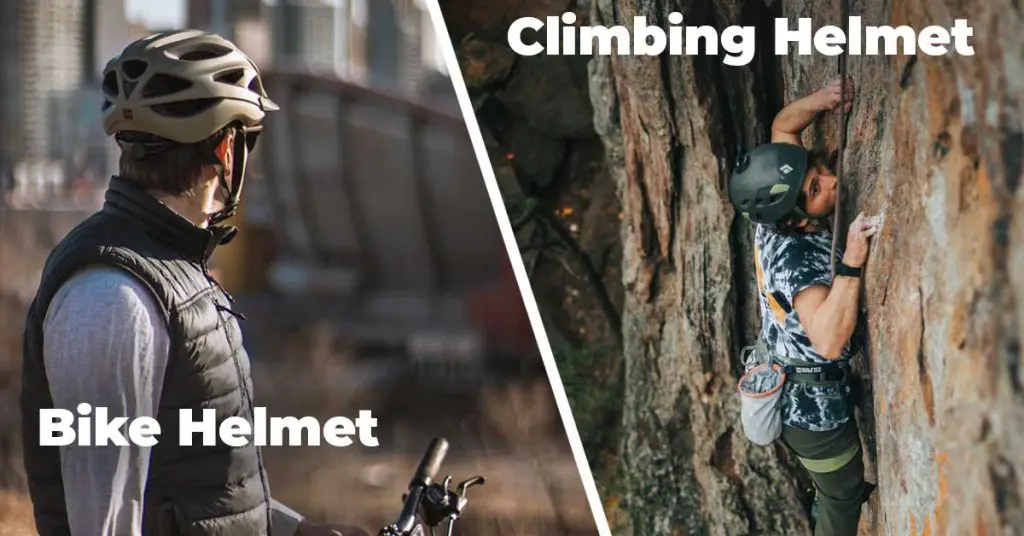Table of Contents
Bike helmets are important for riders of all ages. But what about using a bike helmet for climbing?
I am riding a bicycle regularly and have a bike helmet, so I was wondering if I could wear a bike helmet when I started climbing. I thought there will be no big issue using a bike helmet for climbing but later realized each helmet is made for a specific use and has pros and cons.
Can I use my bike helmet for climbing? The short answer is NO, but something is better than nothing.
A helmet is an important and integral part of biking. It is used to protect the biker’s head, face, and neck in case of an accident. Helmets are usually made of hard plastic, which makes them hard and quite heavy to carry. Thus, the only way to carry it inside the mountain is to put it inside your backpack or on your bike. However, every piece of bike gear is created for a particular bike activity.
Difference between a bike helmet and a climbing helmet
The basic difference between a bike helmet and a climbing helmet is surface material. The climbing helmet is made of thick and hard material while the bike helmet is made of soft material. A bike helmet is meant to be aerodynamic and protect your high-impact fall. Climbing helmets protect you from stones falling from above.
Bike helmets are designed to take one impact and crush while climbing helmets are designed to be better at taking more impacts. Bike helmets are designed to be lightweight.
Is a helmet necessary for climbing?
Yes, a helmet is necessary while climbing. From 60% to 80% of the injuries sustained by rock climbers occur to their heads, and around half of these head injuries are fatal. Helmets are, in fact, the single most important piece of protection for rock climbers, although some athletes have countered this statement by saying that “It’s not whether you wear a helmet, but how you wear a helmet.”
A climbing helmet is not necessary for most people when hiking or biking. However, a climbing helmet may be necessary if you are bouldering, free climbing, or mountaineering. A climbing helmet can protect your head and neck from falls and rocks while you are ascending or descending a cliff.
What are the Different Types of Bike Helmets?
There are several different types of bike helmets, each designed for a specific purpose. Here’s a breakdown of the most common types:
Full-face helmets protect the entire head and face, including the eyes. They’re the safest option for cyclists since they can reduce the risk of head injuries by up to 85%. However, full-face helmets are bulky and uncomfortable to wear for long periods of time. They’re also not suitable for cycling in cold weather conditions since they don’t provide adequate insulation.
A half-face helmet protects only the front portion of your head and face. This type is less protective than full-face helmets, but it’s still important to wear one if you ride in dangerous conditions or during winter months when temperatures drop below freezing. Half-face helmets are also less bulky and generally easier to wear than full-face helmets.
Bucket helmets are made from a lightweight, durable material and protect the head only. They’re not suitable for cycling in cold weather conditions since they don’t provide adequate insulation.
Spinners are like bucket helmets, but they have a built-in mirror that allows you to see behind you. They’re not as protective as full-face or half-face helmets, but they’re more comfortable to wear than traditional bucket helmets.
helmets come in different sizes and shapes, so it’s important to find one that fits snugly but is not too tight. You may also want to adjust the straps so that they are comfortable and do not interfere with your movement.
Also, check the blog post Can I Use a Bike Helmet for Kayaking?
How do you wear a climbing helmet?
Climbing is a fun and exciting sport that can be enjoyed by people of all ages. It is a great way to get your heart rate up, and it can be enjoyed by people of all fitness levels. Climbing can be done with ropes or without ropes, but both methods require climbing helmets to protect the head from injury.
When climbing without ropes, you will need to secure the helmet to your head with an adjustable strap. This strap should fit snugly around your head so that it does not move. When using ropes, you will need to clip the helmet onto the rope using a carabiner or other similar device. Make sure that the clips are in such a way that they do not contact your hair or skin.
Finally, you need to ensure that the helmet fits well. Many climbing helmets come in different sizes, and you should try to find one that fits snugly but is not too tight. You may also want to adjust the straps so that they are comfortable and do not interfere with your movement.
Conclusion:
The safety of using a bike helmet for climbing depends on a variety of factors specific to each individual climb. However, it is advisable to consult with a certified cycling safety instructor before attempting any climbing-specific activity with a bike helmet on. Additionally, always use common sense when climbing use a safe climbing technique, obey all safety guidelines, and wear a helmet that fits well and provides adequate protection.



